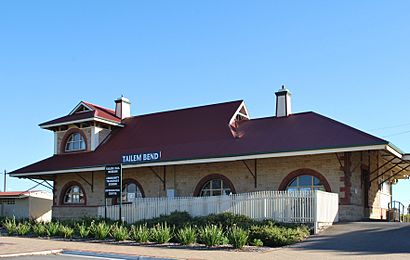Tailem Bend railway station facts for kids
Quick facts for kids
Tailem Bend
|
|
|---|---|

Station front in January 2010
|
|
| Location | Railway Terrace, Tailem Bend |
| Coordinates | 35°15′18″S 139°27′23″E / 35.25500°S 139.45639°E |
| Line(s) | Adelaide-Wolseley Loxton Pinnaroo |
| Distance | 120.50 kilometres from Adelaide |
| Platforms | 1 |
| Construction | |
| Structure type | Ground |
| Other information | |
| Status | Closed |
| History | |
| Opened | 7 October 1913 |
| Closed | 1996 |
Tailem Bend railway station is a historic train station located in Tailem Bend, South Australia. It sits on the main Adelaide-Wolseley line. This station was also a very important meeting point for other train lines, like those going to Loxton and Pinnaroo.
History of Tailem Bend Station
Tailem Bend station first opened its doors on 7 October 1913. It was built as part of the main train line connecting Adelaide and Wolseley. Soon after, it became a "junction station." This means it was a special place where several different train lines met and connected.
One of the first lines to join was the Pinnaroo line, which was built in 1906. Later, in 1913, the Brown's Well line also connected here. This Brown's Well line was eventually extended all the way to Barmera by 1928. Many trains from other branch lines, like Peebinga, Loxton, Moorook, and Waikerie, all passed through Tailem Bend. All these lines were originally built with a "broad gauge," meaning the tracks were a certain width apart.
On 27 June 1926, the station got special facilities to help service and repair locomotives (the engines of the trains). These included a roundhouse, which is a building where train engines can be stored and worked on.
In 1995, a big project changed the Adelaide-Wolseley line. It was converted to "standard gauge." This means the width between the tracks was changed to a different size. Because of this, Tailem Bend became a "break of gauge" station. This was a place where trains had to switch from one track width to another.
The station officially closed in 1996. However, on 22 May 2005, it was reopened as a museum. This allows people to visit and learn about its history. In 1998, the remaining branch lines to Pinnaroo and Loxton were also changed to standard gauge. These two lines eventually closed in 2015, after trains stopped carrying grain on them.

